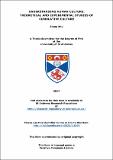Files in this item
Understanding human culture : theoretical and experimental studies of cumulative culture
Item metadata
| dc.contributor.advisor | Rendell, Luke | |
| dc.contributor.author | Miu, Elena | |
| dc.coverage.spatial | xvi, 259 p. | en_US |
| dc.date.accessioned | 2017-11-15T12:13:48Z | |
| dc.date.available | 2017-11-15T12:13:48Z | |
| dc.date.issued | 2017-12-07 | |
| dc.identifier.uri | https://hdl.handle.net/10023/12099 | |
| dc.description.abstract | There is something extraordinary about human culture. The striking complexity of our technologies, institutions, beliefs, and norms has allowed us to colonise the entire planet. One aspect in which human culture is unique relates to its cumulative nature – we accumulate and build on knowledge from the previous generations, leading to incremental improvement in skill, which allows us to produce technologies no one individual could have invented on their own. Understanding the drivers and dynamics of this type of cumulative culture is essential for understanding how human culture has interacted with human evolution. This thesis is concerned with precisely that, and uses a mixture of theoretical and experimental approaches linking individual-level decisions to population-level processes in cumulative culture contexts. Chapter 1 provides some essential background information. In Chapter 2 I used an agent-based simulation model to show that refinement, or incremental improvement in cultural traits, can lead to a drastic decrease of cultural diversity at the population level. This pattern was confirmed using experimental data from a collaborative programming competition in Chapter 3, where I showed that in a cumulative setting, the differential riskiness of copying and innovation drives participants to converge on very similar solutions, leading to a loss of cultural diversity. In Chapter 4 I explored individual differences in social learning strategies, finding considerable variation in how individuals rely on copying, with more successful individuals being more exploratory. I found that successful individuals had more influence on subsequent entries, which is consistent with a prestige bias. Finally, Chapter 5 addressed the link between group structure, diversity, and cumulative improvement. I found that larger groups accumulate more improvement than smaller groups, but smaller groups can also inhibit the convergence patterns we witnessed in larger groups, suggesting an optimal level of connectivity responsible for cumulative improvement. | en_US |
| dc.language.iso | en | en_US |
| dc.publisher | University of St Andrews | |
| dc.rights | Attribution-NonCommercial-NoDerivatives 4.0 International | * |
| dc.rights.uri | http://creativecommons.org/licenses/by-nc-nd/4.0/ | * |
| dc.subject | Cultural evolution | en_US |
| dc.subject | Social learning | en_US |
| dc.subject | Cumulative culture | en_US |
| dc.subject.lcc | HM626.M58 | |
| dc.subject.lcsh | Social evolution | en |
| dc.subject.lcsh | Cognition and culture | en |
| dc.subject.lcsh | Social learning | en |
| dc.title | Understanding human culture : theoretical and experimental studies of cumulative culture | en_US |
| dc.type | Thesis | en_US |
| dc.type.qualificationlevel | Doctoral | en_US |
| dc.type.qualificationname | PhD Doctor of Philosophy | en_US |
| dc.publisher.institution | The University of St Andrews | en_US |
The following licence files are associated with this item:
This item appears in the following Collection(s)
Except where otherwise noted within the work, this item's licence for re-use is described as Attribution-NonCommercial-NoDerivatives 4.0 International
Items in the St Andrews Research Repository are protected by copyright, with all rights reserved, unless otherwise indicated.


